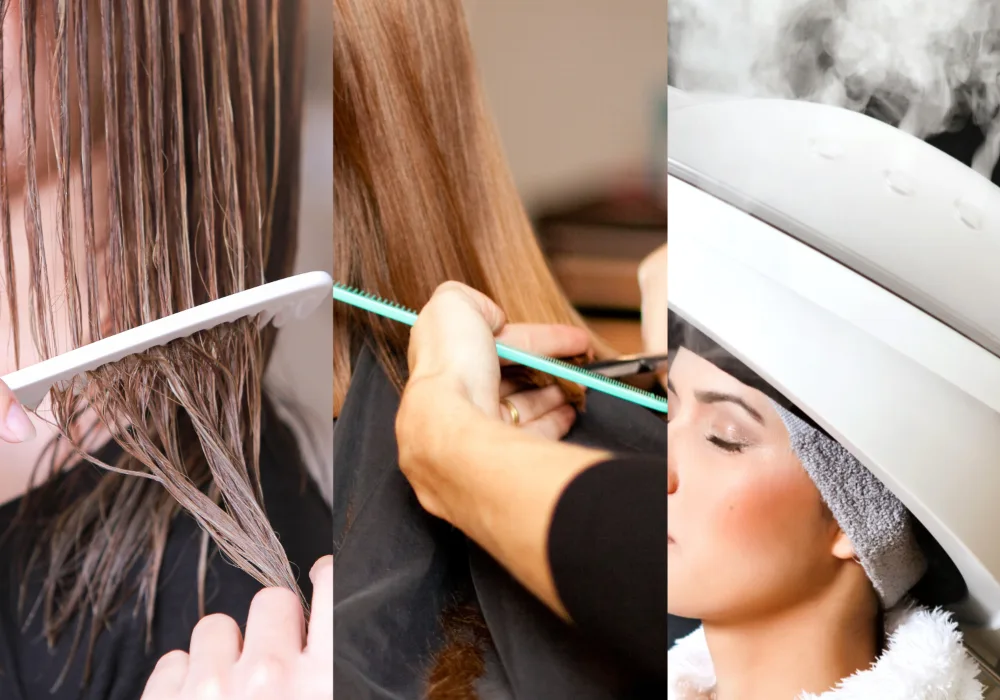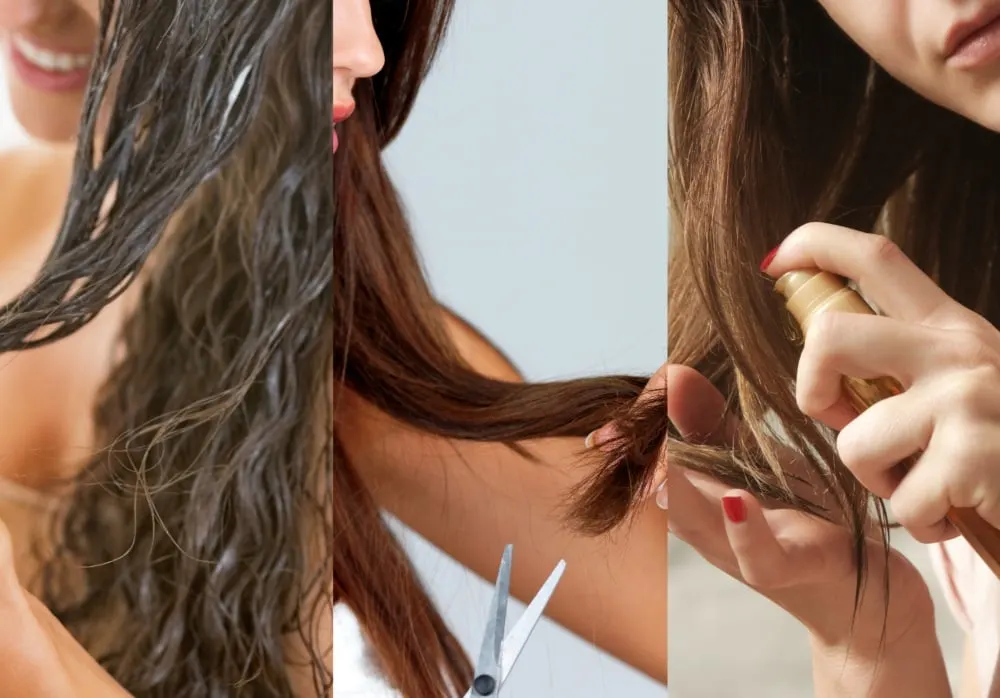Glimpsing in the mirror, have you ever asked yourself why your hair is split all the way up to the point of no return?
Split ends can be a frustrating problem, especially when they seem to grow higher and higher. So why does your hair get split ends so easily?
If your hair is already split too far, you probably want to know how to stop the damage and reclaim your healthy locks.
We’ve got you covered with ways to prevent further damage from occurring, as well as tips on how you can repair existing splits that have grown too far.
What Causes Split Ends?

Split ends occur when the protective cuticle layer of a strand of hair is worn away or damaged. Though genetics can play a part, it often occurs due to external factors, like over-styling, chemical treatments, insufficient moisture, and being too rough with your hair.
When the cuticle layer gets damaged, it splits and creates an overall unkempt look that’s often extremely difficult to manage.
Some people have genetically weak hair that makes it difficult to avoid split ends. Most people struggle with split ends due to external factors.
Overusing Heat Styling Tools
One reason is you could be using styling tools like curling irons, straighteners, and blow dryers too often without protecting your strands with a heat-protectant product first.
Being Rough with Your Hair
Another reason could be brushing or styling hair too harshly. Wearing excessively tight hairstyles and being too rough with wet hair can weaken its structure and leave it prone to breakage from tangles or knots.
Overdoing the Chemical Treatments
Additionally, chemical treatments such as bleaching, coloring, or perming can weaken your strands, making them susceptible to splitting at their tips if not done correctly by a professional stylist who understands how best to care for chemically treated locks afterward.
Environmental Factors
Finally, environmental factors such as windy conditions and sun exposure can dry the hair out, resulting in split ends.
Sun exposure is a key factor since UV rays strip away natural oils from your scalp that help keep our tresses healthy and hydrated all year round.
What Causes Split Ends To Go Up?
When split ends begin to move up the hair shaft, it’s usually due to continued exposure to the same factors that caused the split ends in the first place.
The key to preventing split ends from traveling up the hair shaft is to address the initial causes of hair damage and to regularly trim the ends to prevent further splitting.
Once the ends are split, they are more prone to further damage. Lack of proper hair care after getting split ends will cause it to go all the way up.
Continuing aggressive brushing or styling, using heat styling tools without protection, and repeated chemical treatments can worsen existing split ends and make them appear higher on the hair shaft.
If you don’t trim the split ends and don’t take any steps your hair can split up till the root.
What Happens If Your Split Ends Reach Your Scalp?
Split ends that reach your scalp can lead to hair breaking off right at your scalp and falling out. Also, when split ends get near your roots, they can make your scalp sore and itchy.
Your hair can become so weak that it breaks off faster than it grows. To stop this from happening, it’s really important to stop your hair splits before it reaches the root.
Taking good care of your hair regularly is the best way to avoid the problems caused by split ends reaching your scalp.
My Hair Is Split All The Way Up, What To Do?
To keep split ends from growing up into your hair shaft and causing more damage, regular trims are essential for maintaining healthy-looking locks.
Aim for a trim every 6-8 weeks if you have long hair; every 4-6 weeks should do the trick for shorter styles. This will help you eliminate any existing split ends before they worsen and encourage healthier growth.
Avoid excessive bleaching or coloring sessions, as well as harsh chemical treatments like relaxers or texturizers, which could all contribute towards an increased risk of splits at the ends of your strands.
To prevent further damage to your hair, understand the causes of split ends and take measures such as regular trims and using appropriate products.
How To Prevent Split Ends From Growing Upward?

The common cause of split ends is mechanical damage due to brushing or styling tools such as blow dryers or flat irons.
This kind of damage weakens the protective cuticle layer around each strand of hair, leading to splits at the end that travel up the length of your hair shaft if not taken care of quickly enough.
- To avoid this type of damage, use a wide-toothed comb when detangling wet hair instead of a brush which can tug on individual strands causing breakage and further splitting.
- Additionally, always use heat-protectant products before using any hot styling tools, and make sure you don’t overuse these devices; try only using them once every few days if possible.
- To keep split ends at bay, it’s a good idea to get regular trims every 6-8 weeks, depending on your hair growth rate.
- You should also swap out harsher shampoos for gentler formulas designed specifically for damaged or fragile locks containing ingredients like argan oil and keratin proteins; this will help you strengthen weakened hairs against breakage from everyday activities such as brushing and styling.
- Finally, while it may seem counterintuitive since we just talked about avoiding too much heat exposure – deep conditioning treatments done with steam (or even in the shower) help restore moisture to parched tresses, making them less prone to splitting together.
However, these treatments should be done no more than twice per month, as excessive moisturizing can lead to limpness or greasiness. So make sure you follow instructions carefully when doing one at home.
How To Repair Split Ends That Grown All The Way Up

You can employ certain tactics to help mend your split ends before they become too extreme. Here’s how:
First, use deep conditioning treatments on your hair regularly. This will help strengthen the strands of hair and reduce breakage, which can lead to split ends in the first place.
Second, use heat-protectant products when styling your hair with hot tools such as curling or flat irons. Heat damage is one of the most common causes of split ends, so using a heat-protectant product every time you style your hair will help prevent further damage.
To minimize the potential for split ends, avoid harsh chemicals such as bleach and dyes when possible.
If dyeing or bleaching is necessary, seek the help of an experienced professional who knows their stuff; this will guarantee minimal damage occurs during the process.
Thirdly, regularly trim away existing split ends with sharp scissors. Routine maintenance helps prevent them from traveling further up each strand of hair while also keeping new ones from forming in their place.
Lastly, try using natural oils like coconut oil on dampened locks after washing; this will help you lock moisture into each strand while simultaneously providing nourishment which strengthens against future splitting occurrences.
Wrap Up
The key reason behind your hair splitting all the way up is lack of hair care or excessive styling. The best way to repair split hair that reaches your scalp is to use a quality deep conditioning treatment to restore moisture, elasticity, and strength.
Regular trims can help keep split ends from traveling up the strand of hair. You should also avoid using heat-styling tools on damaged or weakened strands.
Sun exposure and washing with hot water can also weaken hair, making it dryer and frizzier.
